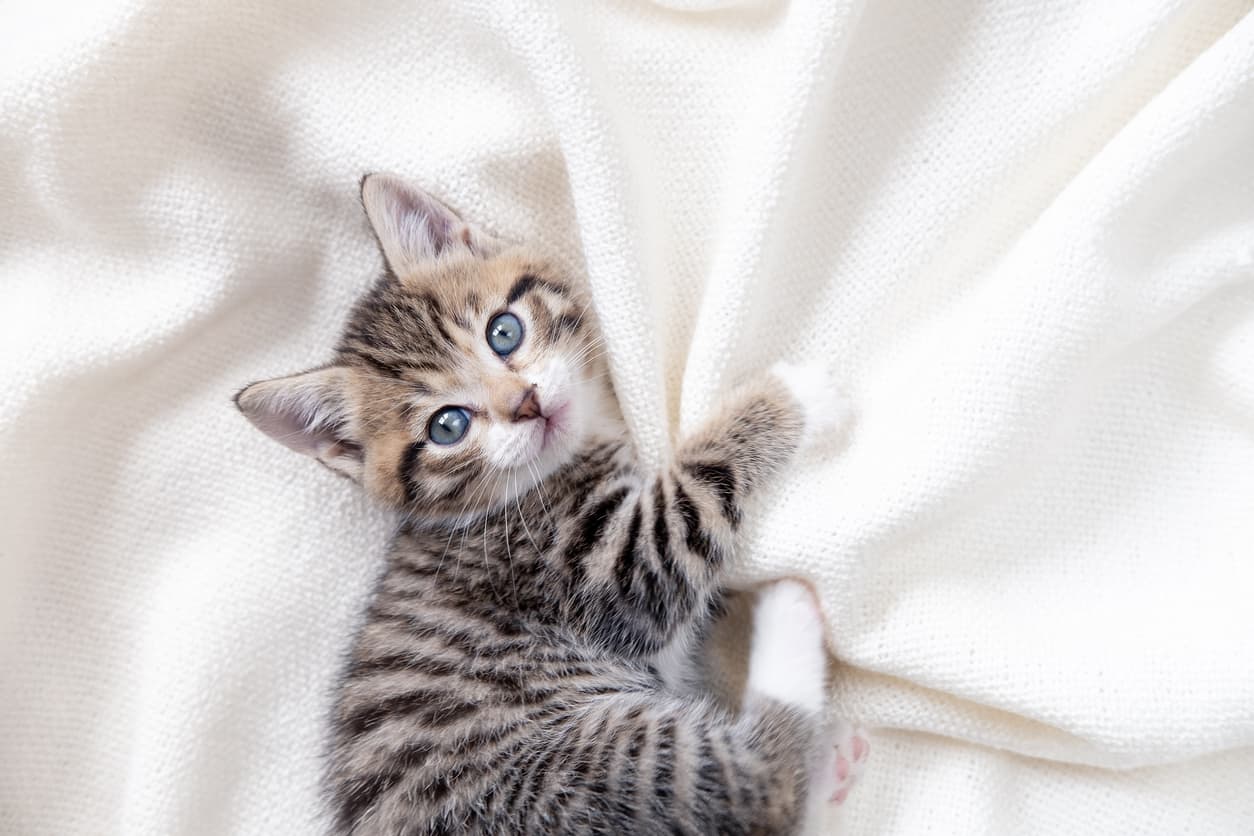How to Take Care of a Kitten [w/ FAQs]

Whether you’re welcoming your first feline family member or you’re a veteran cat parent, welcoming a new kitten into the home is an exciting adventure. Of course, along with the promise of cuteness and years of companionship, comes the anxiety of caring for a newly arrived four-legged friend. This post explores all the stages of caring for a kitten who will grow into a healthy adult cat.
General Care Advice for New Kittens
One of the biggest pieces of advice we can give to new kitten (or puppy) parents is to prepare accordingly. This includes kitten-proofing the house, acquiring a veterinarian and setting expectations regarding proper treatment of animals for young children. Moving into a new home can be stressful for a kitten but preparing for their arrival can help smooth the transition.
Introducing Your New Kitten to Young Children
There’s no reason that a young child and kitten can’t be lifelong friends, but the introductory period is important. The kitten should have a few quiet days to acclimate to their environment. Then, the child can slowly be introduced under supervision. They should be taught before meeting the kitten not to grab or lunge at the kitten and respect its space. Having a child-free space available is important for a kitten to feel safe if it gets overwhelmed.
How to Kitten-Proof Your House
Kittens are notoriously curious and adventurous and will try to play with just about anything in reach. Like human babies, who seem to put everything in their mouths, kittens also go through a similar oral fixation stage. It’s important to keep the ground or any open surfaces clear of wrappers and small items that can be a choking hazard or upset their stomach. Kittens love to climb and can jump high, so be mindful of higher surfaces like end tables or coffee tables. You can deter a kitten from getting onto higher surfaces by covering the edge in sticky tape (cats don’t like being sticky) or aluminum foil. Providing a cat tree or tower can provide your kitten with a safe and elevated area.
A few other tips follow:
- Secure any loose fabrics (like curtains) if possible
- Always close toilet lids and cover wastebaskets
- Cover electric cords and keep charging cables out of reach
- Consider what areas should be off-limit to your kitten. For example, a laundry room or area can be dangerous because they can fall in or get stuck behind the washer and dryer
- Put away or cover any food left out. Kittens have a strong nose and may try to eat foods that are harmful.
- Be aware of toxic chemicals around the house like anti-freeze, which has a sweet taste to animals.
- If you have plants in the house, research whether they are poisonous to cats. Even if they aren’t poisonous, a kitten may try to play with a plant and knock it over.
Help Them Settle In
Kittens are naturally drawn to comfortable, warm and quiet places to sleep and hide. Any cat bed should have higher sides that offer cocoon-like warmth and a low front that provides easy access. We recommend providing a kitten with a cozy corner or area of their own with a cat bed, scratching post, food, fresh water and a litter box. A new home can be an adjustment for a kitten, and a confined area can help ease the transition and simplify litter training.
Selecting a Veterinarian
In addition to gathering supplies, new kitten parents will need to secure a local veterinarian and schedule an initial appointment. Independent pet specialty retailers, local breeders or rescue organizations are all good resources for helping you choose a veterinarian.
Your kitten should see the vet for its first visit at around 8 weeks old. This first visit involves assessing overall health, identifying any congenital issues and screening for parasites. The vet can also walk you through the first year care plan, which includes vaccinations. They can also provide first-time kitten parents with nutrition information and socialization tips.
Must-Have Kitten Supplies
In addition to “kitten-proofing” your home prior to your new family member’s arrival, here are some supplies you’ll want to get:
- Litter box
- Food and water bowls
- Scratching post
- Toys
- Cat carrier
- Cat food approved by the AAFCO for Growth or All Life Stages
- Bedding
- Grooming supplies
How to Groom Your Kitten
The assumption that cats will groom themselves well enough independently is a misconception among new cat parents. Frequent grooming, even for indoor cats, has many benefits. The process of fur brushing will alert you to any skin or coat issues, help find external parasites and hopefully condition your kitten to be a cuddlier companion. It can also prevent hairballs, which form in a cat’s stomach when they ingest too much of their own loose hair. Grooming your kitten can consist of brushing, nail trimming and the occasional bath. Be sure to provide your kitten with treats and praise to encourage a positive association with grooming.
For brushing, a soft-bristle pet brush and comb will work best. Try to brush when your kitten is relaxed or tired. It may be easiest to lay the kitten on your lap and stroke their belly with your hand followed by the brush. When brushing, never pull on the hair or force a brush or comb through knots. This will make grooming an unpleasant process — and association — for your pet. Work out knots by hand with gentle fingers.
Bathing doesn’t need to be a daily activity for cats. Although some cats are comfortable being bathed, most are not. A successful bath starts with preparation. Things like setting up shampoo or medicine bottles and a towel can make all the difference. It’s also important to prepare the water to a comfortable, lukewarm temperature. If you can, try to cut your cat’s nails before bath time to reduce the chances of them scratching you.
Cats tend to get cold so it’s important to dry your kitten quickly. You can dry or swaddle your kitten in a towel. For longer haired kittens, a blow dryer may be needed. It may be necessary to slowly acclimate the kitten to bath time and the noise of the blow dryer by keeping sessions brief at first.
Lastly, get your kitten acclimated to nail trimming early on. It may be easiest to have the kitten on your lap facing away from you. By applying gentle pressure to the upper pad area of the paw, the nails can be more easily extended. If you have an especially nervous kitten, it may be necessary to get them comfortable with the clippers and the sound they make. You can do this by holding your cat on your lap and clipping uncooked spaghetti. Each time you do this, give them a treat. It may be necessary to start out cutting a single nail per day as your kitten builds tolerance.
It’s only necessary to trim the sharp tips of the nail. Be careful to avoid the “quick,” the blood vessel running through the center of the nail. If the nail clipper makes accidental contact with the quick, apply styptic powder to help stop the bleeding.
How to Care for a Newborn Kitten
Kittens will ideally remain with their mother through beyond the newborn stage (from 0-4 weeks of age, though 7-8 weeks is preferred.) In these cases, there is little that needs to be done other than providing a warm, clean and safe environment for the mother to nurse her young. Coupled with veterinarian care, a healthy mother cat usually provides enough nurturing to ensure proper kitten development. If you’re caring for a kitten that’s been separated from its mother, or whose mother is unable to carry out maternal duties, three very important factors become paramount: vet consultation, regular nutrition and regulating body temperature. Your vet can advise you on how to establish a feeding schedule, as well as how to best regulate a kitten’s body temperature. An adequate nutrition plan typically involves bottle feeding every 2-4 hours.
How to Care for a 4-Week-Old Kitten
At around 4 weeks old, kittens start the weaning process from the bottle or their mother’s milk to solid food. It’s important to be patient with yourself and the kitten. Veterinarian Lacie Lee recommends encouraging the kitten to eat from a shallow, wide mouth dish by nudging their muzzle or dipping a paw in. She encourages offering the bottle after feeding time as a reward and to reduce frustration. Also at around 4 weeks, kittens develop their needs for socialization as well as their prey drive. It’s important to encourage play, such as “hunting” a mouse toy or a wand toy.
How to Care for a 6-8-Week-Old Kitten
Monitoring your kitten’s nutritional intake is very important at this point. This is when they will grow baby teeth, which can deter the mother cat from nursing. Transition away from milk or formula to a high quality, protein-rich diet that provides the kitten with adequate nutrition for growth. Monitor their weight gain and physical development according to your vet professional’s guidance.
Careful observation of your brave kitten is increasingly important as the feline’s confidence and curiosity builds over time. Your adventurous kitten will start to get more energy and explore its surroundings. A kitten can find itself in precarious situations and in potentially hazardous areas of the home if left unattended.
How to Care for Your Kitten After 8 Weeks
In addition to rapid growth, kittens develop coordination around 8 weeks old. This allows a kitten to explore areas of the home once thought unreachable, like couches and counters. This is also the time that kittens grow independence and an affinity for adventure. A kitten’s higher energy levels at this age coupled with growing confidence make this a great time to integrate play into their routines. Intellectually stimulating games or activities can help redirect a kitten’s natural sense of mischief. Try capitalizing on your kitten’s hunting instincts with toys that simulate a cat’s natural prey.
FAQs About Kitten Care
Filled with excitement for the arrival of your new feline, you may find yourself with a couple of questions about how to best take care of your kitten. Here are a few common questions new pet owners have.
Q: How many times a day should I feed my kitten?
A: Kittens often thrive on three to five smaller meals a day. The amount will differ depending on their size, age and underlying health. The most important thing to remember when feeding a kitten is ensuring an adequate amount of nutrition. Since their stomachs and GI tracts are smaller than those of adult cats, kittens will generally do better with more frequent, smaller meals throughout the day. As they get older, they can eat two portions a day (meal feeding) or graze throughout the day (free-feeding).
Q: What’s better for a kitten, wet or dry food?
A: With their lower thirst drives, cats are notorious for their predisposition to dehydration. This can lead to long-term urinary and kidney health issue. It’s important to monitor a cat’s hydration levels throughout its whole life. In addition to always providing access to clean drinking water, boosting a cats’ moisture intake with moisture-rich wet foods can help to supplement their hydration. Wet food contains between 75% and 82% moisture compared to 10% to 12% for dry food. Higher-quality shredded cat foods are at the higher end of the moisture levels. Whatever the method, make sure your developing feline is receiving a complete and balanced diet for their life stage.
Q: What should I feed my kitten?
A: Just as you want the highest quality food for you family, you will want the same for your kitten. Look for a food that meets the Association of American Feed Control Officials’ (AAFCO) criteria for “growth” or “all life stages.” It can be overwhelming to find the right food, but reading and understanding cat food labels can help.
Foods with this label will be ideal for kittens to get their required nutrition.
Q: What to do if my kitten is not going to the bathroom regularly?
A: Young kittens may need manual assistance to go to the bathroom.
At RAWZ, our dry and wet minimally processed natural cat foods are optimal for fuzzy friends of all ages. All of our cat food recipes are meal-free, high in protein and tasty to help keep your beloved pet healthy.
Here are a few additional blog posts to help you care for your kitten at all stages of life:








